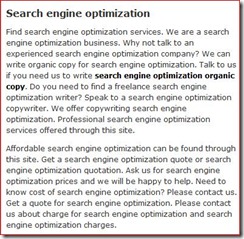Entries from March 2010 ↓
March 31st, 2010 — copywriter, freelance copywriter, search engine optimisation, SEO copywriter
I’ve often talked about the importance of search engine optimisation when creating website copy.
Keyword stuffing is a frequent practice that was done to try and attract the search engine spiders. Web site owners researched their keywords and simply used them as many times as possible within their text.
The hope was that the search spiders would jump for joy because of the number of keywords. And the site would then appear in the top listings because it was deemed highly relevant.
That might have been the hope but the reality was somewhat different. Although sites like these may well have achieved good rankings, their conversion rates were lower than half the teenagers trousers are these days.
The problem is that stuffing your copy with keywords renders it unreadable to people. If they can’t read it or it doesn’t make sense, they’re not going to hang around.
A classic example of this was recently highlighted in one of Nikki Pilkington’s tweets:

This has come from an actual site – a copywriting site! This single snippet contains the phrase ‘search engine optimisation’ no less than 17 times!!!!
Eek! Now do you see what I mean by unreadable?
This is an extreme example and I find it unbelievable that any copywriter would think that this sample of their ‘writing talent’ would convince a client to buy their services.
SEO done correctly will look like normal text. The keywords may not even be obvious because they appear naturally within the copy. After all if you sell orange dog collars, the likelihood is that that phrase is going to pop into your copy anyway.
The position of your keywords is far more important than their frequency.
SEO is a game
The game of SEO is about playing by Google’s rules to achieve good rankings. It’s about patience and research – things won’t happen over night. And above all it’s about understanding what your customer wants.
Unlike other marketing methods that are pushed in front of the reader (such as adverts, newsletters etc.), you can’t push your website in front of someone. Instead you have to make it attractive enough for them to find it.
Therefore you have to understand them and work out what they are searching for. Then, and only then, can you optimise your site and continue tweaking until you get great rankings.
Why do you need to know this?
Don’t get ripped off. If you approach a freelance copywriter to help you with your on page SEO, check out their website:
- Do they rank for their keywords? (if you found them through a Google search and are in the organic listings rather than sponsored links, the answer is yes)
- Is their site readable?
- Do they understand SEO?
- Do they ask you for your keywords?
If you answer no to any of the above they probably aren’t right for you.
If they start harping on about keyword density and their site looks like the one above, run away as fast as you can.
SEO copywriting is an art as much as it is a science – make sure you hire someone who is a Jedi Master in both.
March 29th, 2010 — copywriter, copywriting tips, freelance copywriter, twitter

How can a little social media tool like Twitter possibly improve your writing?
Very easily.
As this great post on Copyblogger by Jennifer Blanchard shows – How Twitter Makes You a Better Writer.
As the Twitter literate out there will know, Twitter messages are limited to 140 characters. And that does mean characters – so every space, punctuation mark and letter or number accounts for one character.
Therefore your writing has to be tighter than, well, a tight thing. There’s no room for adjectives or excessive prose – you have to wrack your brain to find the most succinct way of getting your message across.
Just like when you write sales copy. A copywriter has to keep their writing pithy and to the point. As soon as airy-fairy language creeps in, your reader will walk away.
It takes time to master this, but once you have you’ll discover your Twitter writing will help your copywriting. Your copy will become tighter, punchier and more compelling. You’ll start to take note of every word you use and you’ll be questioning them to ensure you’ve used the most concise and powerful combination to get your message across.
So, put your reserve aside and if you’re not already Tweeting, get started.
If the thought of it still makes you shudder with anxiety, help is at hand. One of the great Twitter Gurus, Mark Shaw (@markshaw), has put together an excellent eBook to help get you started. He’s kindly given me permission to offer it here to anyone who wants it.
So if you want a copy, drop me an email and I’ll send it to you. You can also follow me @sallyormond – why send me your most creative 140 character tweets?
Sally Ormond – freelance copywriter
sally@briarcopywriting.com
March 26th, 2010 — copywriting, freelance copywriter, SEO copywriter

More and more businesses are moving to the internet. But that can cause an issue over web copy.
Many companies sell products made by other manufacturers. But they aren’t going to be that manufacturers only outlet online. So, you then have the situation where you have several websites selling the same products.
There’s nothing wrong with a bit of healthy competition, but there is the issue of duplicate content to worry about.
Most manufacturers will produce standard ‘blurb’ to accompany their product. This will go into details such as how it’s made, main uses, features etc., – you know the kind of thing.
But the problem is that many businesses simply use this standard sales message on their websites too. The result is the same content written in several different places on the web which can seriously damage their search engine results.
So how do you get around this problem?
Well, you’ll either have to get to grips with SEO or hire a good SEO copywriter to write fresh, original content for you.
Yes, copywriters write for a living, but that doesn’t mean they are also mind-readers.
If you want great copy, you have to give a detailed brief identifying exactly what you want. Sometimes people are surprised at the level of information a copywriter needs. But let me ask you something – if you were having a new kitchen fitted would you just point the fitter to your kitchen and leave him to it, or would you pick out the units you wanted, show him where they were to go and decide on a colour scheme?
So, for every product you sell, your copywriter will need the following information:
- What the product is
- What is its major benefit?
- What evidence do you have to back this up?
- What variations does it have (size, colour, shape, speed etc.)
- Are there any reasons why someone wouldn’t buy from you?
- What are its main features?
- What makes this product better than its competitors?
- What objections might your reader have to buying this product?
Then they’ll require information such as:
- What are the primary key phrases you’re targeting on this page?
- What are the secondary key phrases?
- What is your brand personality?/What tone do you want to convey in the copy?
- What do you want your reader to do after reading this page (call you, go to order page, email you…)
Depending on the product, your copywriter may well have other questions to ask.
The key is, whenever you are commissioning a copywriter to write for you, (whether it’s SEO web copy, brochure content, a newsletter etc.) always provide them with loads of information.
When they provide you with a requisition document to assess the project, make sure you answer all their questions as fully as possible. This will give them a better chance of hitting it right first time.
Remember, a copywriter if a professional writer, not a mind reader.
March 24th, 2010 — copywriter, copywriting tips, freelance copywriter, website copywriting

If you’re a bit of a petrol head, I bet the sound of a V8 racing past gets your spine tingling. There’s something very special about that throaty roar.
Normally coupled with a sleek body, gorgeous good looks (yes, I’m still talking about the car) and sumptuous interior, its all your boy-hood (or girl-hood) dreams come true.
A car without one is simply, well a car – just your usual run of the mill banger to get you from A to B.
Is your website a Ferrari or an old banger?
Ask any website designer what pattern a typical visit to their website follows and they’ll tell you:

Basically, a visitor will land on their home page, click through to see examples on their portfolio page and then either get in touch, or go elsewhere.
Why does this happen?
Because many people’s main concern is still the aesthetics of their website. They want it to look slick and sexy. They want flash and loads of images and graphics that look pretty. In other words, they want a Ferrari.
But if this is your main focus when looking for a new website, you’ll probably end up with an old banger.
Don’t get stuck in the scrap yard
You might think a gorgeous looking website can’t fail to sell. You’d be wrong.
A gorgeous looking website on a web designer’s portfolio will sell. But if you try and use it to sell your products, on its own it will fail.
Despite the huge amounts of information on the web about search engine optimisation, many people are still not doing it, or doing it badly.
A fabulous looking website is like a Ferrari without an engine – it’s useless. The engine of your website comes in two forms – its content and links.
The web copy on your site has to be:
- SEO friendly
- Compelling
- Relevant
- Interesting
- Benefits driven
- Unique
A tall order if you’re writing it yourself. If you’re serious about getting the SEO copy right on your website, hire an SEO copywriter to write it for you.
But make sure you chose wisely – beware the copywriter who talks about keyword density or who doesn’t know what an H1 heading is or who can’t explain the significance of a Page Title.
Don’t forget the links
Getting your on-page SEO right is a great start, but then you have to work on your linking strategy.
Google adores one way back links – they are links you get from other websites to yours. There are numerous services out there who claim to be able to build thousands of links for you overnight (practically). But be careful – the best links are those that are from sites relevant to your industry. The most effective way to link build is to do it yourself through article directories (e.g. ezinearticles) and using web 2.0 properties such as Squidoo.
Organic is good for you
You might decide that you want to go pay per click rather than battling with SEO. If you have a large marketing budget then go for it. But if you’re not lucky enough to have bottomless pockets, organic search results really are the best way to market your business today.
The days of consumers turning to the Yellow Pages or local press ads are disappearing fast. Today, even for local searches, people are turning to the internet.
Don’t forget, one advantage the search results have over the Yellow Pages is, if you have one or more search results on page one, you’re pushing your competitors off the front page and onto page 2!
So don’t forget – a great looking website won’t sell your products. Relevant, interesting copy will.
March 22nd, 2010 — copywriter, freelance copywriter, SEO copywriter, twitter

Do you use Twitter?
If so, how do you use it?
For a lot of people, Twitter is all about getting as many followers as possible. They don’t care who they are, just so long as their Twitter page shows an astronomically large number of follows.
But for others (me included), Twitter is more about quality rather than quantity. You see, Twitter is a relationship tool. It’s not about who can get the most followers. It’s about who’s out there in the Twitterverse that can add value to your life/business and visa versa.
It can be a fabulous tool for gathering information, finding new partners for business projects, identifying potential new clients. But above all, it allows you to build relationships and trust by giving and sharing great information.
…and the copywriting?
Yeah, OK, I was just getting to that bit.
Let’s take website copywriting as an example. When creating copy for a website, you have to take the reader into consideration. After all you are trying to attract them to the site so you have to write benefits led copy that they’re going to find interesting.
You will utilise SEO skills to ensure you attract targeted traffic to the site.
“Who cares – I just want loads of traffic!”
Sure, everyone wants loads of traffic to their website, but would you rather have 100 visitors a day who don’t hang around or 10 highly targeted visitors who not only visit your site, they also buy.
Just think about that. Every day your site would get 10 buying customers – 70 in a week – 3640 per year.
Of course, to get this type of targeted traffic you’ll have to do your research carefully. Use free keyword tools like Google’s to find your target audience – oh, and start with local key phrases rather than generic ones as the local ones are easier to rank for.
Get your key phrases into your page titles and headings and then write your web copy with them in mind. Don’t worry about density – that’s no longer relevant and you’ll find writing naturally will automatically bring in the right saturation of key terms.
So you see, Twitter is a lot like copywriting. Quantity isn’t that important – it’s the quality that really counts.











